ShodhKosh: Journal of Visual and Performing ArtsISSN (Online): 2582-7472
|
|
Conceptual Photography: Significance and Future in Indian Photography
1 Assistant
Professor, Department of Applied Arts, Rajasthan School of Arts, Jaipur,
Rajasthan, India
|
|
ABSTRACT |
||
|
Conceptual photography is a form of art that uses photographs to convey abstract ideas, concepts, and emotions rather than depicting reality. It is an expressive and creative approach that allows photographers to explore their imagination and produce visually stunning images. Unlike traditional photography that captures the reality of the subject, conceptual photography goes beyond the surface and aims to evoke thought-provoking responses from the viewer. This research article aims to explore the significance and future of conceptual photography. By contrasting
conceptual photography with traditional photography and other related genres,
the article highlights conceptual photography's unique characteristics,
techniques, and objectives. Through the lens of renowned Indian conceptual
photographers, the piece demonstrates how this genre resonates with diverse
societal issues and challenges conventional perceptions. The article presents
a comprehensive overview of conceptual photography's transformative power in
shaping artistic expression and encouraging profound intellectual engagement. |
|||
|
Received 15 May 2023 Accepted 22 September 2023 Published 27 September 2023 Corresponding Author Kritika
Agarwal, kritikaagarwal0@gmail.com DOI 10.29121/shodhkosh.v4.i2SE.2023.527 Funding: This research
received no specific grant from any funding agency in the public, commercial,
or not-for-profit sectors. Copyright: © 2023 The
Author(s). This work is licensed under a Creative Commons
Attribution 4.0 International License. With the
license CC-BY, authors retain the copyright, allowing anyone to download,
reuse, re-print, modify, distribute, and/or copy their contribution. The work
must be properly attributed to its author.
|
|||
|
Keywords: Conceptual Photography, Indian Photography,
Significance, Future, Art |
|||
1. INTRODUCTION
Photographers of the recent times are very much excited with the technological advancement from it being manual to digital. The digital age has given new possibilities to the photographers and has become less time consuming and with cost effectiveness. It has often become difficult for a photographer that what he/she should capture. Whether they should capture the world around them or they should capture their thoughts and ideas. Capturing the world around is a conventional approach and on the other hand Conceptual photography is about depicting ones thoughts or feelings. Further, the term conceptual photography becomes a great topic of debate i.e., it is a form of photo manipulation or a traditional form of photography or it is something else. Hence, it has becomes very difficult to define and understand the parameters of Conceptual photography for a photographer. Moreover, in layman terms people have misconceptions regarding the conceptual photography or they completely don’t understand the term. The purpose of this study was to review published –research and available information to develop better understanding of conceptual photography and its parameters within Indian context. Further, it will also throw light on Indian photographers who have contributed in the field and talked about the cultural and social relevance of this genre of photography. The study will inculcate some of the pioneers of conceptual photography namely- Pushpamala N, Diwan Manna, Sharbendu De, Gauri Gill, Atul Bhalla to provide deeper insights about this form of photography.
2. Methodology
This study uses qualitative research
methods and an exploratory research design, involving a comprehensive review of
the existing literature on conceptual photography. For collecting primary data,
interviews with Indian photographers were conducted to gain insights into their
experiences and perceptions of this art form. These interviews were designed to
be open-ended, allowing participants to contribute insightful information about
the subject. The secondary data was collected from various websites, books,
research article, e-journals, and other web sources.
3. Discussion
Conceptual photography is a significant art form that has
been expanded over the last few years and resonates with a wide range of audience
across various demographics. The conceptual photography is a genre of
photography which focuses on exploring abstract ideas and concepts through
visual imagery. Rather than simply documenting the world as it exists,
conceptual photography is often created with the purpose of conveying a deeper
meaning or message. It can be highly experimental and innovative. Conceptual
photographers investigate a wide range of ideas which can be achieved by staged
photography, as it gives them freedom to effectively communicate their desired
ideas Conceptual Photography Explained
With Examples. (2021). This
genre has a power which pushes the boundaries of traditional photography and
exploring new ways of representing the world.
Conceptual art is the origin of conceptual
photography, which can be dated around 1960s to 1970s. In conceptual art, an
idea or concept is significant rather than the aesthetics and technique, and is mostly used to represent the abstract
through physical material Conceptual Photography Explained
With Examples. (2021). The pioneers of conceptual
photography were artists who sought to use photography as a tool for exploring
abstract ideas and emotions. These artists rejected the idea of photography as
a medium for capturing reality. Instead, they used photography to convey
abstract concepts, often through the use of text,
symbols, and metaphor. Sol Lewitt, Cindy Sherman, Yves Klein, are among the
well-known photographers.
Figure 1

|
Figure 1 Crowd, No. 8 by Misha
Gordin. |
To develop a better understanding of Conceptual photography
it was compared with the traditional form of photography.
·
In terms of subject matter, traditional photography focuses
on capturing the reality of the subject whereas the conceptual photography is
more concerned with communicating an idea or emotion.
·
In terms of intent, traditional photography is to
document reality and creates aesthetically pleasing images or it is capturing
a moment in time. In contrast, conceptual photography is to evoke
thought-provoking responses from the viewer and challenge conventional ways of
thinking.
·
In terms of subjectivity, traditional photography
is objective and aims to represent the subject as accurately as possible,
whereas conceptual photography is subjective and aims to represent the
photographer's interpretation of an idea or concept.
·
In terms of techniques, traditional photography
relies on techniques such as composition, lighting, and framing to capture the
subject. On the other hand, in conceptual photography employs techniques such
as symbolism, metaphor, and surrealism to convey abstract concepts and
emotions.
·
In terms of post-processing, traditional
photography is often limited in terms of post-processing, with minimal
adjustments made to enhance the picture, while in conceptual photography
extensive post-processing is practiced to enhance or
alter the image and convey a precise message.
The outcome of traditional photography is typically
a photograph that represents reality, whereas the outcome of conceptual
photography is a photograph that represents an idea or concept.
The conceptual photography is often misunderstood with the other genre of photography like storytelling and digital manipulation, but it is far different for the goners. To get a crisp knowledge about the parameter of conceptual photography, it was compared with the different approaches of photography.
1)
Storytelling
Photography vs Conceptual Photography
Storytelling photography and Conceptual photography are
two distinct genres of photography, each with its own unique characteristics
and objectives. The differences are as followed:
·
Storytelling photography focuses on telling a
story or narrative through a series of photographs, whereas conceptual photography
focus on exploring abstract ideas and concepts.
·
Storytelling photography follows a specific plot
or storyline. On the other hand conceptual photography
has no clear storyline instead it is open for interpretations.
·
Storytelling photography has reach of wider
audience, as works are more accessible and relatable. While,
conceptual photography appeals to intellectual or art-oriented audience.
·
Storytelling photography intends to convey a
specific story or a message. In contrast, conceptual photography challenges
traditional modes of representation and explore new ideas and concepts.
The key difference is that storytelling photography and conceptual photography are two distinct genres of photography, each with its own unique characteristics and objectives. Storytelling photography is focused on conveying a narrative or a story through a series of images, while conceptual photography is more focused on expressing abstract ideas and exploring themes such as identity and culture.
2)
Digital
Manipulation vs Conceptual Photography
Digital manipulation and conceptual photography are
two different approaches to create art with photographs. While both can involve
editing and manipulating images, there are some key differences between these
two genres:
·
Digital manipulation is to alter or enhance a
photograph for aesthetic or practical purposes, whereas conceptual photography
aims to convey a message or idea through the image.
·
Digital manipulation can be done on an existing
photograph, whereas in conceptual photography a photograph is captured in a
controlled environment.
·
Digital manipulation involves altering a
pre-existing photograph using software tools, while conceptual photography
involves creating an image from scratch that conveys an abstract idea or
concept.
·
Digital manipulation allows for a high level of
creative control over the final image. In contrast, conceptual photography
requires more planning, and experimentation to create the desired image.
·
Digital manipulation may create a final image that
is far from the original photograph, while conceptual photography often
involves some level of abstraction, but still maintains a connection to the
original subject matter.
·
Digital manipulation is often used in commercial
advertising or editorial work. On the
other hand, conceptual photography is primarily used for artistic expression
and exploration of abstract ideas.
·
Digital manipulation is often used in commercial
photography, advertising, or for enhancing personal photographs, whereas
conceptual photography is primarily used for artistic expression and
exploration.
In brief, digital manipulation and conceptual
photography are distinct approaches to create art with photographs. Digital
manipulation involves altering and enhancing pre-existing photographs for
aesthetic or practical purposes, while conceptual photography involves creating
an image from scratch that conveys a specific message or idea.
The lack of a well processed out concept, when perfectly executed, can still result in a poor photograph. Consequently, the most essential component of a strong picture is the concept and the combination of the ability to conceive a concept and to execute it are the two primary components of a successful conceptual photograph Misha (2013).
4. Indian Context
1)
Pushpamala N
Pushpamala N was one of the pioneer conceptual
photographers from the land of India. She began experimenting with the
medium in the late 1980s. Pushpamala N. was a trained
painter and performance artist. In 1982, she was graduated, followed by her Master’s degree in 1985 from the Maharaja Sayajiro University of Baroda Pushpamala (2023). She became interested in photography
as a means of exploring ideas around gender, identity, and its representation. She is renowned
for being a strong feminist for rejecting the idea of authenticity and being
open to different ways of looking at things. Being a pioneer in conceptual art
of India and her innovative work in photography, sculptures, video, and
performance has had a huge impact on art in India. She's interested in history
and the concept of cultural memory, and often challenges the traditional images
from art, photography, movies, theatre, and popular culture, thus positioning
herself as the focal point of social and political investigation in India Pushpamala (n.d.)
Figure 2

|
Figure 2 Toda H
by Pushpmala N; c. 2004. Sepia Toned Silver
Gelation Print; Size: 8.8 x 13.1 cm; at Museum of Art & Photography
(MAP), Bengaluru. |
Figure 3

|
Figure 3 Lady
in Moonlight by Pushpmala N, Clare Arni; c. 2004.
Sepia Toned Silver Gelation Print on Warm Tone Archival Fibre Paper; Size:
8.8 x 13.1 cm; at Museum of Art & Photography (MAP), Bengaluru. |
2)
Diwan Manna
Another well-known, pioneer of conceptual photography from
the land of India is Diwan Manna. In 1977, he studied art at
Government College of Art, Chandigarh in graphic art/print making and completed
his art training in 1982 Diwan Manna (n.d.). In his work, he employs a combination of
photography, painting, body art and acting to produce works that defy
categorization. In his work, rather than showing images of the destruction of
human kindness, bravery, and beauty, he seeks to tap into the hidden, yet
undiscovered, depths of humanity in people (Figure 4 and Figure 5). He seeks to
create a space for people from different backgrounds, cultures, languages, and
political groups which give a strong experience of emotions that restores one
with a feeling of loss of humanity. Through his work, Diwan talks about how
social violence affects people, how life is hard for men and women who live in
the shadows like forgotten people, and how lonely people are and how much they
suffer. On perceiving his pictures, one gets both disturbing and exhilarating
experience. Moreover, it reveals our innermost humanity which turns into a
journey of self-discovery for each of us Diwan Manna. (n.d.).
Figure 4
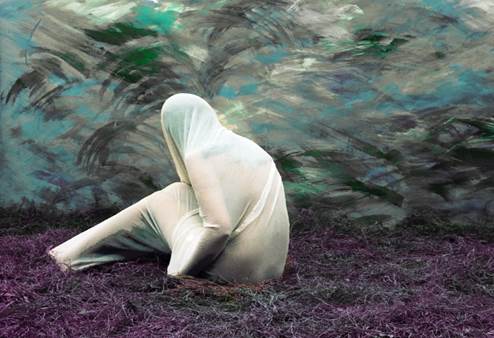
|
Figure 4 Shores of the
Unknown New 1 by Diwan Manna. Source
https://www.diwanmanna.com/photo-gallery#prettyPhoto1[gallery2]/0/ |
Figure 5

|
Figure 5 Violence Series 3 by
Diwan Manna. Source
https://www.diwanmanna.com/photo-gallery#prettyPhoto3[gallery2]/2/ |
3)
Sharbendu De
Sharbendu De, a conceptual photographer who
is notable for his work for Indian indigenous communities, ecology, and
environment conservation. He grew up in Andaman and Nicobar Islands. He perused
his post-graduation diploma in journalism from the renounced Indian Institute
of Mass Communication, New Delhi About (n.d.). Later, in 2010, he was graduated in photojournalism from the University
of Westminster, London, UK. After which he professionally started his career in
the field of photography Sharbendu (n.d.). His love for
nature and environment can be seen in his work. His artwork acts as a window
into the future and portrays the living standards of humankind. His work makes
one think about the question “where would we go once all of this outside in the
natural atmosphere is gone?”, which can be observed in Figure 6 and Figure 7. With his
pictures he is trying to make futuristic speculations. He desires that people
should stop and have a closer look to think what is happening and why it is
happening and question their position in the future. He hopes that by the
process of engaging with the images, people go back looking for the answers.
Figure 6
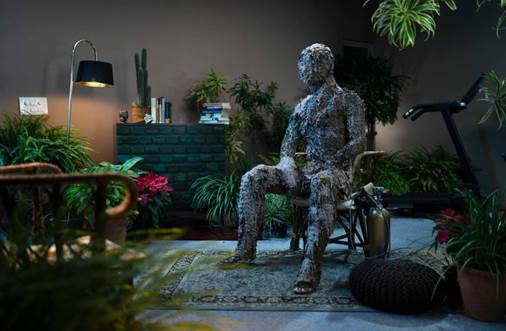
|
Figure 6 New Nature, An Elegy
for Ecology, 2021: by Sharbendu De. |
Figure 7
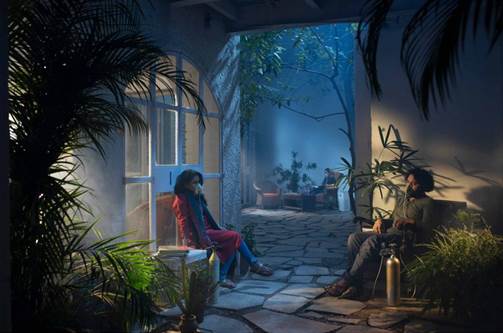
|
Figure 7
Oxygen Cafe, An Elegy for Ecology, 2021: by Sharbendu
De. |
4)
Gauri Gill
Gauri Gill, an Indian photographer, is renowned for her conceptual documentary-style photography, which explores themes of identity and tradition, as well as the experiences of marginalized communities. Gauri Gill was born and raised in New Delhi, India, and obtained her Bachelor's and Master's degrees in applied art and photography from the Delhi University, followed by another Master's degree in fine arts from Stanford University in the United States Bio. (n.d.).
Throughout her career, she has been captivated by India’s rich cultural heritage and has travelled extensively throughout the country, capturing the essence of India’s people and culture. Many of her photographs explore the lives of people and communities who are often marginalized or ignored by mainstream society. She has consistently sought to foster an intimate relationship with her subjects in order to gain a better understanding of them and to capture their narrative through her lenses Agarwal (2019). Gauri Gill’s photographs have been widely exhibited in renowned galleries and museums worldwide, and have been widely praised for their compassionate depiction of human experience and sentiment.
Her lens captures moments that bridge the gap between reality and imagination. Her photographs often transcend the surface, encapsulating layers of emotion, identity, and cultural heritage. From Figure 8 and Figure 9 it is easy to say that she has a keen eye for detail and sensitivity to her subjects, she crafts images that evoke a visceral response from viewers. She delves into issues such as identity, gender, tradition, and the intricacies of human relationships. She creates visual narratives that prompt contemplation and encourage a revaluation of one’s perceptions. Her conceptual photography stands as a testament to her ability to use the medium to convey complex ideas and provoke thought. Her work has left an indelible mark on the world of photography, inspiring audiences to engage with her images on a profound and intellectual level.
Figure 8
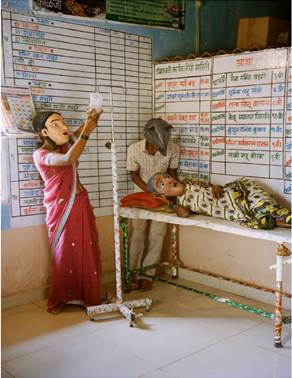
|
Figure 8 ‘This Wasn’t About
Making a Comment on Hygiene in Hospitals’ … Untitled (9) by Gauri Gill, from
the Series Acts of Appearance, 2015. |
Figure 9

|
Figure 9 Untitled (27) by
Gauri Gill, from the Series Acts of Appearance, Archival Pigment Print- 42 x
28 Inches, 2015. |
5)
Atul Bhalla
The
renowned Indian photographer Atul Bhalla is known for his conceptual
photographs that delve into the themes of urbanization, environmental issues,
and the complex relationship between human beings and their environment. He
earned his B.F.A. for the College of Art, Delhi University and his post-graduation
from School of Art of Northern Illinois University, US Sinha
& Sterberger (2007).
His work
highlights the environmental issues, particularly related to water, for more
than two decades. He primarily works through photography, which allows him to
explore the ecological politics of water, as well as the histories and
associations of places of daily living, often constructing narratives through
performances Bhalla
(n.d.). Moreover, his work focuses on the changing urban
environment and the profound effects of urbanization on the environment and on
people’s lives. He beautifully balances the man-made with the nature,
emphasizing the tension, harmony and sometimes extreme
contrast between the two.
Through his picture, Bhalla poses important questions about sustainability, air pollution, and the effects of unchecked development. His photographs not only document the physical changes that occur in urban areas, but also the psychological and emotional changes that happen to people and communities. From Figure 10 and Figure 11 it is easy to say that his work, serves as a medium of current concerns that shape modern society. Bhalla's work combines a unique combination of aesthetic and message, prompting viewers to revaluate their role in the urban landscape and the collective responsibility to protect the natural environment. As a visionary conceptual photographer, Atul Bhalla has left an indelible mark on the world of art, inspiring huge audience to engage critically with their surroundings and consider the profound implications of urbanization and environmental change.
Figure 10
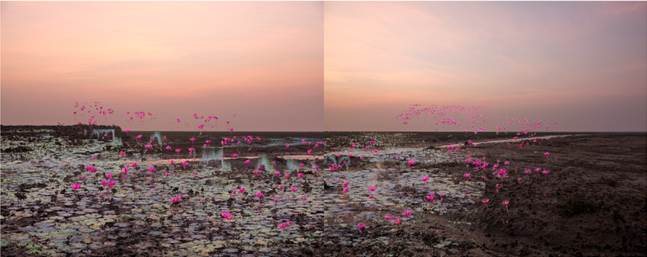
|
Figure 10 Nostalgia-I by Atul
Bhalla, Archival Pigment Print- 16 x 64 Inches, 2020. |
Figure 11

|
Figure 11 Intervention by Atul
Bhalla, Archival Pigment Print- 10 x 12 Inches, 2019. Source
https://www.vadehraart.com/artists/32-atul-bhalla/works/39605-atul-bhalla-interventions-2019/ |
These are just a few of the many Indian conceptual
photographers who have gained recognition for their innovative and experimental
approaches to photography. Not just this, photographers from different genres
like commercial photography, fashion, storyteller etc. has started practicing
the conceptual photography and making their artworks more meaning full.
5. Conclusion
In conclusion, conceptual photography stands as a powerful
and evolving art form that has expanded its boundaries over recent years,
captivating a diverse audience across various demographics. This genre, rooted
in the exploration of abstract ideas and concepts through visual imagery, goes
beyond mere documentation, aiming to convey deeper meanings and messages.
Conceptual photography's experimental and innovative nature allows artists to
push the limits of traditional photography, introducing new ways of perceiving
the world. Moreover, it has an immense power to make people
think or question the world around us.
Comparisons with traditional photography shed light on
conceptual photography's distinctive qualities. While traditional photography
emphasizes reality and aesthetics, conceptual photography thrives on
idea-driven narratives that challenge perceptions. Contrasting conceptual
photography with storytelling and digital manipulation photography further
underscores its distinctiveness. The subjectivity in conceptual photography
allows photographers to interpret concepts uniquely, fostering an intellectual
engagement with viewers. Techniques like symbolism, metaphor, and surrealism
are harnessed to communicate complex abstract ideas, transcending the
conventional visual language.
Conceptual photography remains a vital and growing
genre in India, where artists are continuing to explore new techniques and
ideas. Examining Indian conceptual photographers such as Pushpamala
N, Diwan Manna, Sharbendu De, Gauri Gill, and Atul
Bhalla demonstrates the genre's impact in diverse contexts. These artists discuss
social, environmental, and cultural issues, provoking contemplation
and empathy. Their works bridge the gap between reality and imagination,
capturing intricate layers of emotion, identity, and societal challenges.
While studying for the topic it was found
that there is a need for greater institutional support and recognition for
conceptual photography in India. The future of conceptual photography in India
is promising, and with the right support and resources, it has the potential to
become a major force in the global art scene (Acharya, V. Interviewer, 2023,
March 10).
In essence, conceptual photography is more than just a visual art form; it's a vehicle for expressing intricate concepts and pushing the boundaries of perception. It transcends traditional photography, inviting viewers to engage intellectually and emotionally, fostering a deeper understanding of the world's complexities. As artists continue to innovate within this genre, conceptual photography remains a catalyst for change and introspection in the art world and beyond.
CONFLICT OF INTERESTS
None.
ACKNOWLEDGMENTS
None.
REFERENCES
About. (n.d.). De Sharbendu. Retrieved From 2023, March 11.
Agarwal, K. (2019). Breaking the Taboos of Indian Society with the Special Reference of Indian Female Photographers. Journal of the Gujarat Research Society, 21(5), 84–87.
Bhalla, A. (n.d.). Vadehra Art Gallery. Retrieved From 2023, August 6.
Bio. (n.d.). Retrieved 6 August 2023, From https://www.gaurigill.com/bio.html
Diwan Manna. (n.d.). Retrieved From 2023, March 11.
Diwan Manna. (n.d.). Retrieved From 2023, March 11.
Pushpamala N. (n.d.). Retrieved From 2023, March 9.
Conceptual Photography Explained With Examples. (2021, December 12). StudioBinder.
Manna, D. (n.d.). Contemporary Conceptual Artrist/Photographer—Diwan Manna. Retrieved From 2023, March 4.
Misha, G. (2013). Conceptual Photography : Idea, Process, Truth. World Literature Today, 87(2), 76. https://doi.org/10.7588/worllitetoda.87.2.0076.
Pushpamala, N. (2023). In Wikipedia.
Sharbendu, D. (n.d.). MAP Academy. Retrieved From 2023, March 11.
Sinha, G., & Sterberger, P. (2007). India Public and Private Spaces : Contemporary Photography and Video Art. The Marg Foundation and The Newark Museum (1 September 2007).
|
|
 This work is licensed under a: Creative Commons Attribution 4.0 International License
This work is licensed under a: Creative Commons Attribution 4.0 International License
© ShodhKosh 2023. All Rights Reserved.

